
The 506th Infantry Regiment, originally designated the 506th Parachute Infantry Regiment during World War II, is an airborne light infantry regiment of the United States Army. Currently a parent regiment under the U.S. Army Regimental System, the regiment has two active battalions: the 1st Battalion, 506th Infantry Regiment is assigned to the 1st Brigade Combat Team, 101st Airborne Division, and the 2nd Battalion, 506th Infantry Regiment is assigned to the 3rd Brigade Combat Team, 101st Airborne Division.
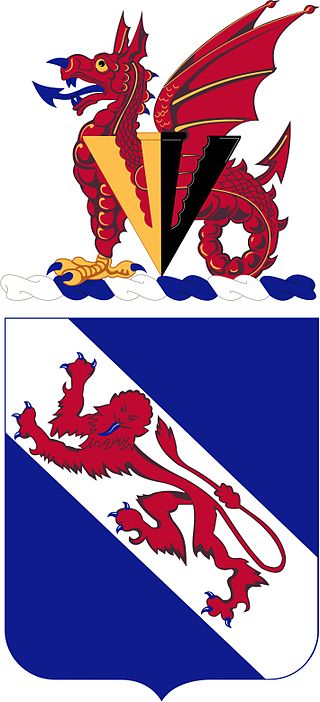
The 508th Infantry Regiment is an airborne infantry regiment of the United States Army, first formed in October 1942 during World War II. The 508th is a parent regiment under the U.S. Army Regimental System, and two battalions from the regiment are currently active: the 1st Battalion, 508th Parachute Infantry Regiment is assigned to the 3rd Brigade Combat Team, 82nd Airborne Division, and the 2nd Battalion, 508th Parachute Infantry Regiment is assigned to the 2nd Brigade Combat Team, 82nd Airborne Division. The regiment served in combat during World War II, and regimental elements have served in combat in the Dominican Republic, Vietnam, Grenada, Panama, Iraq and Afghanistan.
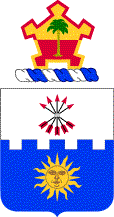
The 22nd Infantry Regiment is a parent regiment of the United States Army. Currently the 2nd Battalion is active, with the regimental colors residing at Fort Drum, New York. The 1st, 3rd, and 4th Battalions have been inactivated.

The 39th Infantry Regiment is a parent regiment in the United States Army. Originally organized for service in World War I, the 39th fought in most of the conflicts involving the United States during the 20th century, and since 1990 the 2nd Battalion has served as a training unit stationed at Fort Jackson, South Carolina. The 3rd Battalion was started on 21 October 2015 and a 4th Battalion was added in July 2017.

The 26th Infantry Regiment is an infantry regiment of the United States Army. Its nickname is "Blue Spaders", taken from German soldiers in World War I who saw the spade-like device on the regiment's distinctive unit insignia and called the soldiers “Blauerspadern”. The 26th Infantry Regiment is part of the U.S. Army Regimental System; currently only the 1st Battalion is active and assigned to the 2nd Brigade Combat Team, 101st Airborne Division.

The 325th Infantry Regiment is an infantry regiment of the 82nd Airborne Division. The regiment serves as the 82nd Airborne's light infantry parachute insertion fighting force of the United States Army, with a long and distinguished history, having taken part in World War I, World War II, the Vietnam War, the invasions of Grenada and Panama, as well as the Gulf and Iraq Wars. The subordinate units of the regiment constitute the bulk of the infantry elements assigned to the 2nd Infantry Brigade Combat Team, 82nd Airborne Division.

The 14th Infantry Regiment is a United States Army light infantry regiment. It has served in the American Civil War, Boxer Rebellion, World War II, Korean War, Vietnam War, Operation Restore Hope, Operation Uphold Democracy, Operation Joint Guard, Operation Desert Storm, Operation Enduring Freedom, Operation Gothic Serpent, Operation New Dawn, Operation Resolute Support,Operation Iraqi Freedom, and Operation Inherent Resolve. The 14th Infantry Regiment did not take part in combat during World War I. It has also conducted peacekeeping and humanitarian missions in the Sinai Peninsula, Guantánamo Bay in Cuba, Bosnia, and Kosovo.
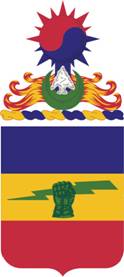
The 73rd Cavalry Regiment is a Cavalry Regiment in the United States Army, first formed in 1941. Three squadrons of the 73rd Cavalry Regiment provided reconnaissance, surveillance, and target acquisition (RSTA) to the Brigade Combat Teams of the 82nd Airborne Division through July 2024 when the last of the three squadrons was deactivated. 3rd Squadron was assigned to 1st Brigade, 1st Squadron was assigned to 2nd Brigade, 5th Squadron was assigned to 3rd Brigade, and 4th Squadron was assigned to 4th Brigade.
The 77th Armor is an armored (tank) regiment of the United States Army. The 77th Armor Regiment is part of the U.S. Army Regimental System with only a single battalion, the 1st Battalion, 77th Armor Regiment, and is therefore classified as both a single battalion and the remainder of the Regiment itself. 1–77 AR is currently stationed at Fort Bliss, Texas as part of the 3rd Brigade "Bulldogs", 1st Armored Division and has transformed from a tank pure battalion into a combined arms battalion (CAB).
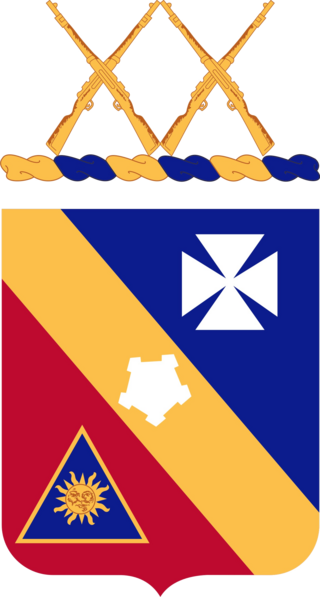
The 20th Infantry Regiment is a United States Army infantry regiment. Currently only the 5th Battalion of the 20th Infantry still exists. Stationed at Joint Base Lewis-McChord and part of the 1st Stryker Brigade Combat Team, 2nd Infantry Division, 5-20 Infantry was one of the original battalions selected to take part in the testing and fielding of the U.S. Army's then-new Stryker vehicle. During the Vietnam War, elements of the regiment carried out the My Lai massacre.

The 21st Infantry Regiment ("Gimlet") is a United States Army infantry regiment. The 1st Battalion currently exists as part of 2nd Infantry Brigade Combat Team, 25th Infantry Division. The regiment fought in World War II, the Korean War and the Vietnam War, as well as Operation Iraqi Freedom. Task Force Smith, the first American unit to see action in the Korean War, was derived from the regiment's 1st Battalion.
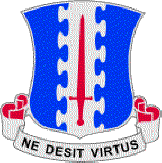
The 3rd Battalion, 187th Infantry Regiment, also known as the Iron Rakkasans, is a battalion of the US Army 187th Infantry Regiment. The battalion was activated on 25 February 1943 and first saw action in the Pacific Theater of the Second World War, during the battle to regain US control of the Philippines. Troops from the battalion then served in the four-year occupation of Japan, where they earned their nickname "Rakkasans", before stationing in Fort Campbell, Kentucky. The battalion served in the Korean War from 1950 as the 187th Airborne Regimental Combat Team and participated in 12 major missions during the Vietnam War, emerging from that conflict as the US's most highly decorated airborne battalion. In 1992 they were designated as the "Iron" Rakkasans by Lieutenant Colonel David Petraeus due to his Leader Rakkasan physical fitness test that added a fourth element of pull-ups to the standard APFT. The battalion has received numerous awards and commendations, including six Presidential Unit Citations and four Valorous Unit Awards.
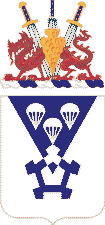
The 2nd Battalion, 503rd Infantry Regiment is an active duty airborne infantry battalion in the United States Army, assigned to the 173rd Airborne Brigade Combat Team and stationed at Caserma Del Din, Vicenza, Italy. The battalion has served with the 2nd Infantry Division, the 11th Airborne Division, the 24th Infantry Division, The 25th Infantry Division, the 82nd Airborne Division, the 101st Airborne Division, and the 173rd Airborne Brigade; has been stationed in Korea, Germany, Italy and the United States; and earned campaign credits in World War II, the Vietnam War, Operation Enduring Freedom—Afghanistan, and Operation Iraqi Freedom.
The 8th Field Artillery Regiment is a field artillery regiment of the United States Army first formed in 1916. The regiment served in World War I, World War II, and Korea, and regimental units have served in Vietnam, Honduras, Panama, Operation Desert Storm, Operation Enduring Freedom and Operation Iraqi Freedom. Currently organized as a parent regiment under the U.S. Army Regimental System, the regiment's only active component is the 2nd Battalion, 8th Field Artillery Regiment, currently assigned to the 1st Infantry Brigade Combat Team, 11th Airborne Division and stationed at Fort Wainwright, Alaska.

The 15th Field Artillery Regiment (FAR) is a field artillery regiment of the United States Army first formed in 1916. A parent regiment under the U.S. Army Regimental System, the 15th FAR currently has two active battalions: the 1st Battalion, 15th Field Artillery Regiment, is assigned to the 1st Brigade Combat Team, 2nd Infantry Division, while the 2nd Battalion, 15th Field Artillery Regiment, is assigned to the 2nd Brigade Combat Team, 10th Mountain Division.

The 43rd Air Defense Artillery Regiment is an air defense artillery regiment of the United States Army first constituted 1918 in the Regular Army.
The 105th Cavalry Regiment is a regiment in the United States Army National Guard.

The 1st Battalion, 503rd Infantry Regiment is an active duty airborne infantry battalion in the United States Army, assigned to the 173rd Airborne Brigade Combat Team and stationed in Vicenza, Italy. The battalion has served with the 2nd Infantry Division, the 11th Airborne Division, the 24th Infantry Division, the 82nd Airborne Division, and the 173rd Airborne Brigade; has been stationed in Korea, Italy and the United States; and earned campaign credits in World War II, the Vietnam War, Operation Enduring Freedom-Afghanistan, and Operation Iraqi Freedom.
The 120th Field Artillery Regiment is a field artillery regiment of the Wisconsin Army National Guard.
The 10th Engineer Battalion is a unit of the United States Army that deploys to designated contingency areas and conducts combat and/or stability operations in support of a brigade combat team. It is a divisional mechanized combat engineer unit, composed of four line companies and a headquarters company. As of 17 January 2015, the battalion exists as the 10th Brigade Engineer Battalion at Fort Stewart, GA under the 1st Armored Brigade Combat Team, 3rd Infantry Division.













